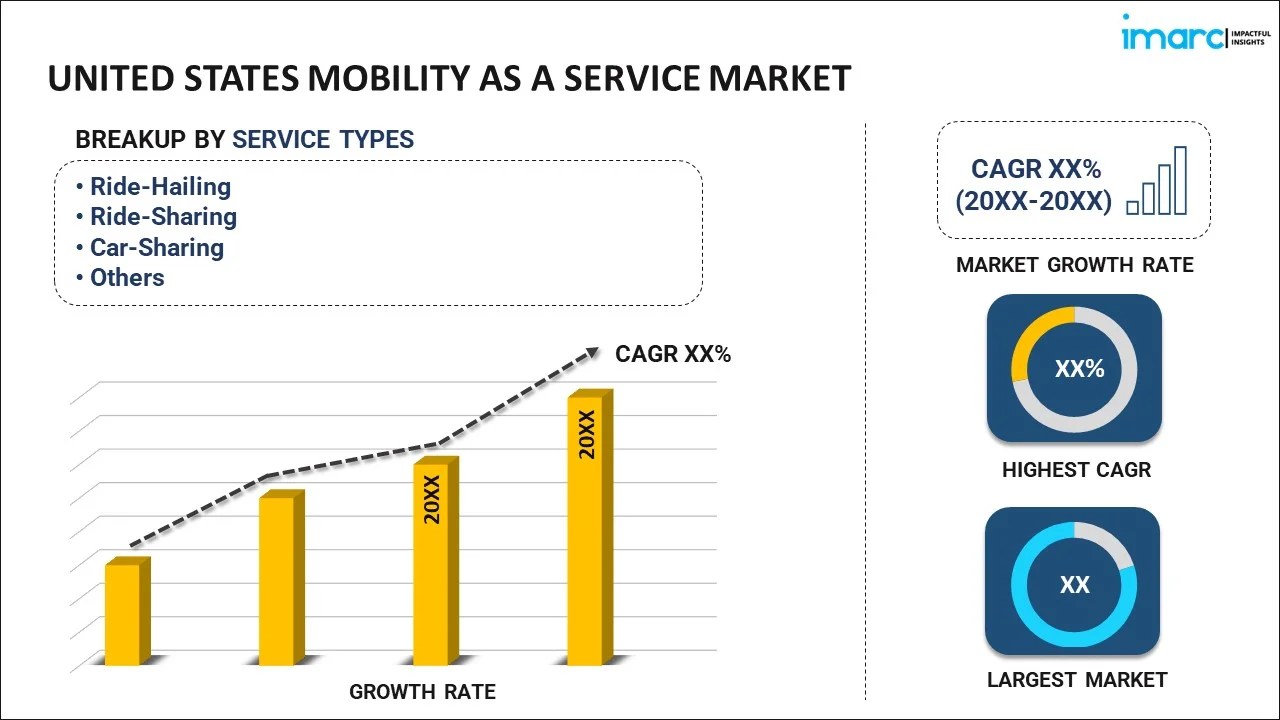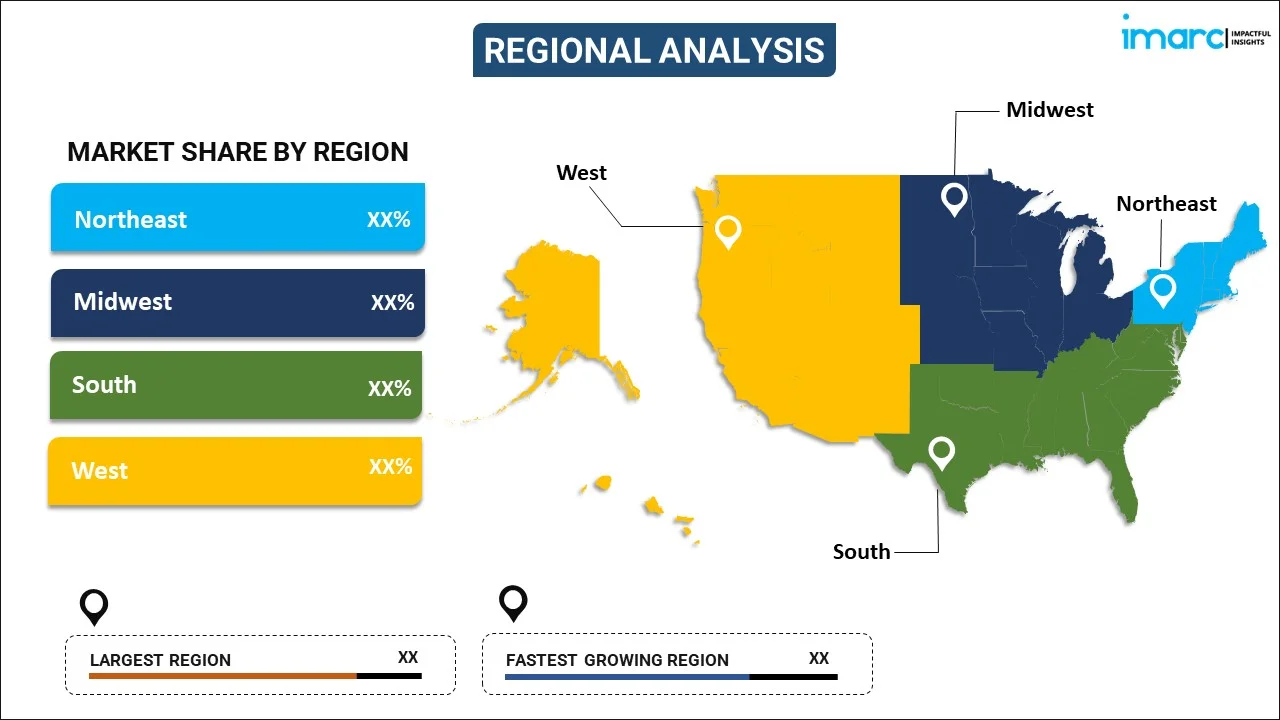
United States Mobility as a Service Market Report by Service Type (Ride-Hailing, Ride-Sharing, Car-Sharing, Bus/Shuttle Service, and Others), Transportation Type (Private, Public), Application Platform (Android, iOS, and Others), Propulsion Type (Electric Vehicle, Internal Combustion Engine, and Others), and Region 2025-2033
Market Overview:
United States mobility as a service market size reached USD 2.6 Billion in 2024. Looking forward, IMARC Group expects the market to reach USD 36.7 Billion by 2033, exhibiting a growth rate (CAGR) of 34.5% during 2025-2033. The rising concerns about traffic congestion and environmental issues that enhance the need for smarter and more sustainable transportation options, are driving the market.
|
Report Attribute
|
Key Statistics
|
|---|---|
|
Base Year
|
2024
|
|
Forecast Years
|
2025-2033
|
|
Historical Years
|
2019-2024
|
|
Market Size in 2024
|
USD 2.6 Billion |
|
Market Forecast in 2033
|
USD 36.7 Billion |
| Market Growth Rate 2025-2033 | 34.5% |
Mobility as a service (MaaS) is a paradigm shift in transportation, integrating various modes like public transit, ride-sharing, biking, and more into a unified, user-centric platform. It aims to simplify and enhance the travel experience by providing a one-stop solution for planning, booking, and paying for diverse transportation services. Users can access real-time information, plan multi-modal journeys, and seamlessly transition between modes, promoting efficiency and sustainability. MaaS leverages digital technology, data analytics, and smart infrastructure to optimize routes, reduce congestion, and minimize environmental impact. By prioritizing the user's needs and offering a holistic approach to mobility, MaaS envisions a future where transportation is not just a means of getting from point A to B but a personalized, interconnected, and sustainable ecosystem that enhances urban living.
United States Mobility as a Service Market Trends:
The mobility as a service market in the United States is rapidly gaining traction, driven by a confluence of factors that underscore its transformative potential in the transportation industry. Firstly, the increasing urbanization necessitates innovative solutions to manage the escalating demand for efficient and sustainable transportation. As cities expand, the need for seamless, integrated mobility solutions becomes imperative, propelling the MaaS market forward. Moreover, the rise of smartphone penetration acts as a catalyst for MaaS adoption. With smartphones becoming ubiquitous, they serve as powerful tools to access and utilize MaaS platforms, offering users unprecedented convenience in planning and executing their journeys. Concurrently, the growing awareness and emphasis on environmental sustainability fuel the demand for eco-friendly transportation alternatives. MaaS, by aggregating various modes of transport and promoting shared mobility options, aligns with this regional shift towards greener practices. Furthermore, the escalating costs associated with private vehicle ownership and maintenance are prompting individuals to explore more cost-effective and flexible mobility solutions. MaaS, with its emphasis on pay-per-use models and diverse transportation options, addresses this financial incentive, making it an attractive choice for consumers. In essence, the interplay of urbanization, technological advancements, environmental consciousness, and economic considerations propels the MaaS market in the United States, positioning it as a pivotal force shaping the future of transportation.
United States Mobility as a Service Market Segmentation:
IMARC Group provides an analysis of the key trends in each segment of the market, along with forecasts at the country levels for 2025-2033. Our report has categorized the market based on service type, transportation type, application platform, and propulsion type.
Service Type Insights:

- Ride-Hailing
- Ride-Sharing
- Car-Sharing
- Bus/Shuttle Service
- Others
The report has provided a detailed breakup and analysis of the market based on the service type. This includes ride-hailing, ride-sharing, car-sharing, bus/shuttle service, and others.
Transportation Type Insights:
- Private
- Public
A detailed breakup and analysis of the market based on the transportation type have also been provided in the report. This includes private and public.
Application Platform Insights:
- Android
- iOS
- Others
The report has provided a detailed breakup and analysis of the market based on the application platform. This includes android, iOS, and others.
Propulsion Type Insights:
- Electric Vehicle
- Internal Combustion Engine
- Others
A detailed breakup and analysis of the market based on the propulsion type have also been provided in the report. This includes electric vehicle, internal combustion engine, and others.
Regional Insights:

- Northeast
- Midwest
- South
- West
The report has also provided a comprehensive analysis of all the major regional markets, which include Northeast, Midwest, South, and West.
Competitive Landscape:
The market research report has also provided a comprehensive analysis of the competitive landscape. Competitive analysis such as market structure, key player positioning, top winning strategies, competitive dashboard, and company evaluation quadrant has been covered in the report. Also, detailed profiles of all major companies have been provided.
United States Mobility as a Service Market Report Coverage:
| Report Features | Details |
|---|---|
| Base Year of the Analysis | 2024 |
| Historical Period | 2019-2024 |
| Forecast Period | 2025-2033 |
| Units | Billion USD |
| Scope of the Report | Exploration of Historical and Forecast Trends, Industry Catalysts and Challenges, Segment-Wise Historical and Predictive Market Assessment:
|
| Service Types Covered | Ride-Hailing, Ride-Sharing, Car-Sharing, Bus/Shuttle Service, Others |
| Transportation Types Covered | Private, Public |
| Application Platforms Covered | Android, iOS, Others |
| Propulsion Types Covered | Electric Vehicle, Internal Combustion Engine, Others |
| Regions Covered | Northeast, Midwest, South, West |
| Customization Scope | 10% Free Customization |
| Post-Sale Analyst Support | 10-12 Weeks |
| Delivery Format | PDF and Excel through Email (We can also provide the editable version of the report in PPT/Word format on special request) |
Key Questions Answered in This Report:
- How has the United States mobility as a service market performed so far and how will it perform in the coming years?
- What has been the impact of COVID-19 on the United States mobility as a service market?
- What is the breakup of the United States mobility as a service market on the basis of service type?
- What is the breakup of the United States mobility as a service market on the basis of transportation type?
- What is the breakup of the United States mobility as a service market on the basis of application platform?
- What is the breakup of the United States mobility as a service market on the basis of propulsion type?
- What are the various stages in the value chain of the United States mobility as a service market?
- What are the key driving factors and challenges in the United States mobility as a service?
- What is the structure of the United States mobility as a service market and who are the key players?
- What is the degree of competition in the United States mobility as a service market?
Key Benefits for Stakeholders:
- IMARC’s industry report offers a comprehensive quantitative analysis of various market segments, historical and current market trends, market forecasts, and dynamics of the United States mobility as a service market from 2019-2033.
- The research report provides the latest information on the market drivers, challenges, and opportunities in the United States mobility as a service market.
- Porter's five forces analysis assist stakeholders in assessing the impact of new entrants, competitive rivalry, supplier power, buyer power, and the threat of substitution. It helps stakeholders to analyze the level of competition within the United States mobility as a service industry and its attractiveness.
- Competitive landscape allows stakeholders to understand their competitive environment and provides an insight into the current positions of key players in the market.
Need more help?
- Speak to our experienced analysts for insights on the current market scenarios.
- Include additional segments and countries to customize the report as per your requirement.
- Gain an unparalleled competitive advantage in your domain by understanding how to utilize the report and positively impacting your operations and revenue.
- For further assistance, please connect with our analysts.
 Inquire Before Buying
Inquire Before Buying
 Speak to an Analyst
Speak to an Analyst
 Request Brochure
Request Brochure
 Request Customization
Request Customization




.webp)




.webp)












